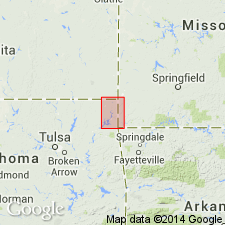
- Usage in publication:
-
- Moccasin Bend Member*
- Modifications:
-
- Named
- Dominant lithology:
-
- Limestone
- Chert
- AAPG geologic province:
-
- Chautauqua platform
- Cherokee basin
Summary:
Named as uppermost member (of 7) of Boone Formation; named for its type locality on Spring River 6 mi east of Miami, Ottawa Co, OK. Area of this report is in Picher field, a mining districts which straddles the OK-KS State line just a few miles west of the MO State line on the Chautauqua platform and Cherokee basin. Consists of alternating chert and fine- to medium-grained brown limestone, cotton rock (or tripoli). Chert is conspicuously brown and blue in lower part, paler above. Comprises the lettered units from B to H beds (Fowler, 1942). Within the Wyandotte quad, is 0-140 ft thick; increases rather gradually in original stratigraphic thickness from eastern to western part in the mining field; 60 ft thick near Spring River, 140 ft thick southwest of Melrose, KS. Conformably overlies Baxter Springs Member (named) of Boone Formation; is overlain in at least a part of the mining field by the Quapaw Limestone (named) of Warsaw or Salem age. Contains fossils scattered at different levels. Isopach map; geologic map; cross section; stratigraphic table. Of Late Mississippian, Meramec age.
Source: GNU records (USGS DDS-6; Denver GNULEX).
For more information, please contact Nancy Stamm, Geologic Names Committee Secretary.
Asterisk (*) indicates published by U.S. Geological Survey authors.
"No current usage" (†) implies that a name has been abandoned or has fallen into disuse. Former usage and, if known, replacement name given in parentheses ( ).
Slash (/) indicates name conflicts with nomenclatural guidelines (CSN, 1933; ACSN, 1961, 1970; NACSN, 1983, 2005, 2021). May be explained within brackets ([ ]).

